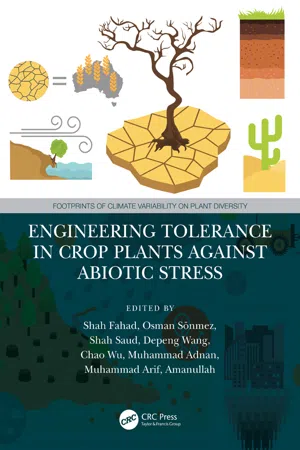1
Biochar: An Adsorbent to Remediate Environmental Pollutants
Iqra Mehmood, Amna Bari, Mehtab Muhammad Aslam, Eyalira Jacob Okal, Muhammad Riaz, Muhammad Tahir ul Qamar, Muhammad Adnan, Mukhtar Ahmed, Shah Saud, Fazli Wahid, Muhammad Noor, and Shah Fahad
DOI: 10.1201/9781003160717-1
CONTENTS
1.1 Introduction
1.2 Types of Water Pollutants Treated by Adsorbents
1.2.1 Biological Pollutants
1.2.2 Soluble and Non-soluble Contaminants
1.2.3 Heavy Metals
1.2.4 Dyes
1.2.5 Phenols
1.2.6 Other Substances
1.3 Adsorbents
1.3.1 Biochar
1.4 Production of Biochar
1.4.1 Pyrolysis Process
1.5 Factors Affecting Biochar Properties
1.6 Remediation of Organic Contaminants from Water and Soil using Biochar
1.7 Remediation of Inorganic Contaminants from Water and Soil using Biochar
1.8 Interaction Mechanisms of Biochar with Contaminants
1.8.1 Organic Contaminants
1.8.2 Inorganic Contaminants
1.9 Modified Types of Biochar
1.9.1 Magnetic Biochar
1.9.2 Chemically Modified Biochar
1.9.3 Biochar Coated Nanoparticles
1.10 Conclusion and Future Perspectives
References
1.1 Introduction
Water is one of the most important natural resources that are very essential for survival of all living organisms. As WHO (world health organization) and some other studies revealed that of the 100% of water is randomly distributed on earth, 97.5% is sea water concentrated with salt (Millero et al. 2008; Pawlowicz 2015). Therefore, the larger percentage of water present on the earth’s surface cannot be used for drinking purposes without treatment. In general, 2.5% of water on earth is fresh, out of which 70% is frozen in the form of either glaciers or ice or occurs as underground water. It is worth noting that less than 1% of available water is suitable for human consumption and other household uses (Gupta et al. 2009). The small percentage of available clean water is often contaminated by pollutants that are generated from human activities such as mining, industrialization, sewage leakage, and use of agrochemicals (Ayuso and Foley 2016; Christophoridis et al. 2019; Khan et al. 2013; Vareda et al. 2019; Yang et al. 2020). The majority of anthropogenic activities strongly depend on water availability and are known to have a negative impact on water resources. Furthermore, agricultural production heavily relies on water availability (Schwarzenbach et al. 2010). The use of chemicals and dyes in industries, and pesticides in agricultural practices continuously contribute to water pollution due to toxic organic and inorganic compounds released into the ecosystem (Fatta-Kassinos et al. 2011; Li et al. 2011; O’Connor 1996). According to United Nations world water development, two million tons of waste are disposed of daily into natural water resources. These waste materials mainly originate from industries, households and agricultural activities, which contribute to water pollution due to emitted pesticides, herbicides, insecticides, fertilizers, and human waste (Programme 2003). In addition, heavy metals significantly contribute to the pollution of natural water resources and also pose serious harm to human health (Akinci et al. 2013; Al-Musharafi et al. 2013; Fujita et al. 2014; Naser 2013). Due to their subtle nature, heavy metals are not easily degraded by microbes, and therefore, remain persistent in the environment for many years (Xu et al. 2012a). Heavy metals in the environment leach down into natural water resources from where they enter into the food chain through plants and later affect animal and human health (Mashhadizadeh and Karami 2011; Nassar 2010; Zhong et al. 2007). Different methods utilized to remove heavy metals from water include membrane separation (Doke and Yadav 2014), constructed wetlands (Sultana et al. 2014), ion exchange (Cavaco et al. 2007), chemical precipitation (Kurniawan et al. 2006), ultra-filtration (Chakraborty et al. 2014), reverse osmosis, synthetic coagulants, and photocatalytic oxidation (Dimitrov 2006; Friedrich et al. 1998). These methods are, however, costly and time-consuming. Pros and cons of these strategies have already been discussed in various studies (Clifford et al. 1986; Kurniawan et al. 2006; Mohan and Pittman Jr 2006; Owlad et al. 2009). In contrast, adsorption is cheaper, environment-friendly and adaptive approach that is often preferred in removing organic and inorganic pollutants from waste water. Adsorbents are porous materials that adhere or adsorb waste materials to remove them from the water. In this chapter, we propose to discuss various types of absorbent...
